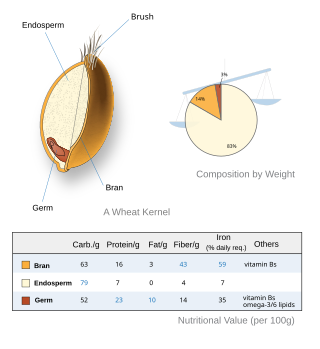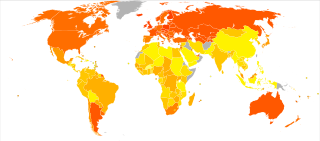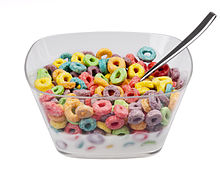
Food is any substance consumed by an organism for nutritional support. Food is usually of plant, animal, or fungal origin and contains essential nutrients such as carbohydrates, fats, proteins, vitamins, or minerals. The substance is ingested by an organism and assimilated by the organism's cells to provide energy, maintain life, or stimulate growth. Different species of animals have different feeding behaviours that satisfy the needs of their metabolisms and have evolved to fill a specific ecological niche within specific geographical contexts.

Abdominal obesity, also known as central obesity and truncal obesity, is the human condition of an excessive concentration of visceral fat around the stomach and abdomen to such an extent that it is likely to harm its bearer's health. Abdominal obesity has been strongly linked to cardiovascular disease, Alzheimer's disease, and other metabolic and vascular diseases.

Human nutrition deals with the provision of essential nutrients in food that are necessary to support human life and good health. Poor nutrition is a chronic problem often linked to poverty, food security, or a poor understanding of nutritional requirements. Malnutrition and its consequences are large contributors to deaths, physical deformities, and disabilities worldwide. Good nutrition is necessary for children to grow physically and mentally, and for normal human biological development.

Weight loss, in the context of medicine, health, or physical fitness, refers to a reduction of the total body mass, by a mean loss of fluid, body fat, or lean mass. Weight loss can either occur unintentionally because of malnourishment or an underlying disease, or from a conscious effort to improve an actual or perceived overweight or obese state. "Unexplained" weight loss that is not caused by reduction in calorific intake or increase in exercise is called cachexia and may be a symptom of a serious medical condition.

The Mediterranean diet is a diet inspired by the eating habits and traditional food typical of southern Spain, southern Italy, and Crete, and formulated in the early 1960s. It is distinct from Mediterranean cuisine, which covers the actual cuisines of the Mediterranean countries, and from the Atlantic diet of northwestern Spain and Portugal. While inspired by a specific time and place, the "Mediterranean diet" was later refined based on the results of multiple scientific studies.

Maltodextrin is a name shared by two different families of chemicals. Both families are glucose polymers, but have little chemical or nutritional similarity.
Prebiotics are compounds in food that foster growth or activity of beneficial microorganisms such as bacteria and fungi. The most common environment considered is the gastrointestinal tract, where prebiotics can alter the composition of organisms in the gut microbiome.

A healthy diet is a diet that maintains or improves overall health. A healthy diet provides the body with essential nutrition: fluid, macronutrients such as protein, micronutrients such as vitamins, and adequate fibre and food energy.

A whole grain is a grain of any cereal and pseudocereal that contains the endosperm, germ, and bran, in contrast to refined grains, which retain only the endosperm.

Pet food is animal feed intended for consumption by pets. Typically sold in pet stores and supermarkets, it is usually specific to the type of animal, such as dog food or cat food. Most meat used for animals is a byproduct of the human food industry, and is not regarded as "human grade".

Food marketing is the marketing of food products. It brings together the food producer and the consumer through a chain of marketing activities.

Antinutrients are natural or synthetic compounds that interfere with the absorption of nutrients. Nutrition studies focus on antinutrients commonly found in food sources and beverages. Antinutrients may take the form of drugs, chemicals that naturally occur in food sources, proteins, or overconsumption of nutrients themselves. Antinutrients may act by binding to vitamins and minerals, preventing their uptake, or inhibiting enzymes.

Diet plays an important role in the genesis of obesity. Personal choices, food advertising, social customs and cultural influences, as well as food availability and pricing all play a role in determining what and how much an individual eats.
Nutrition psychology (NP) is the psychological study of the relationship between dietary intake and different aspects of psychological health. It is an applied field that uses an interdisciplinary approach to examine the influence of diet on mental health. Nutrition psychology seeks to understand the relationship between nutritional behavior and mental health/well-being NP is a sub-field of psychology and more specifically of health psychology. It may be applied to numerous different fields including: psychology, dietetics, nutrition, and marketing. NP is a fairly new field with a brief history that has already started to contribute information and knowledge to psychology. There are two main areas of controversy within nutrition psychology. The first area of controversy is that the topic can be viewed in two different ways. It can be viewed as nutrition affecting psychological functions, or psychological choices and behavior influencing nutrition and health. The second controversy is the defining of what is "healthy" or "normal" as related to nutrition.

Preventive Nutrition is a branch of nutrition science with the goal of preventing, delaying, and/or reducing the impacts of disease and disease-related complications. It is concerned with a high level of personal well-being, disease prevention, and diagnosis of recurring health problems or symptoms of discomfort which are often precursors to health issues. The overweight and obese population numbers have increased over the last 40 years and numerous chronic diseases are associated with obesity. Preventive nutrition may assist in prolonging the onset of non-communicable diseases and may allow adults to experience more "healthy living years." There are various ways of educating the public about preventive nutrition. Information regarding preventive nutrition is often communicated through public health forums, government programs and policies, or nutritional education. For example, in the United States, preventive nutrition is taught to the public through the use of the food pyramid or MyPlate initiatives.

As in the human practice of veganism, vegan dog foods are those formulated with the exclusion of ingredients that contain or were processed with any part of an animal, or any animal byproduct. Vegan dog food may incorporate the use of fruits, vegetables, cereals, legumes including soya, nuts, vegetable oils, as well as any other non-animal based foods.

Geoffrey Cannon is an English author, journalist and former magazine editor, and scholar. From 1968 to 1972, he was the music critic for The Guardian, a role that made him the first dedicated rock critic at a British daily newspaper. Having worked as the arts editor for New Society magazine, he became editor of the BBC publication Radio Times from 1969 to 1979. During that time, he also wrote on music and pop culture for The Listener, the Los Angeles Times, the Chicago Sun-Times, Creem, Rock et Folk, Melody Maker and Time Out.

Hyperpalatable food (HPF) combines high levels of fat, sugar, sodium, or carbohydrates to trigger the brain's reward system, encouraging excessive eating. The concept of hyperpalatability is foundational to ultra-processed foods, which are usually engineered to have enjoyable qualities of sweetness, saltiness, or richness. Hyperpalatable foods can stimulate the release of metabolic, stress, and appetite hormones that play a role in cravings and may interfere with the body's ability to regulate appetite and satiety.

The Nova classification is a framework for grouping edible substances based on the extent and purpose of food processing applied to them. Researchers at the University of São Paulo, Brazil, proposed the system in 2009.
Carlos Augusto Monteiro is a Brazilian nutritionist who is known for coining the term ultra-processed food and introducing the Nova classification.




















